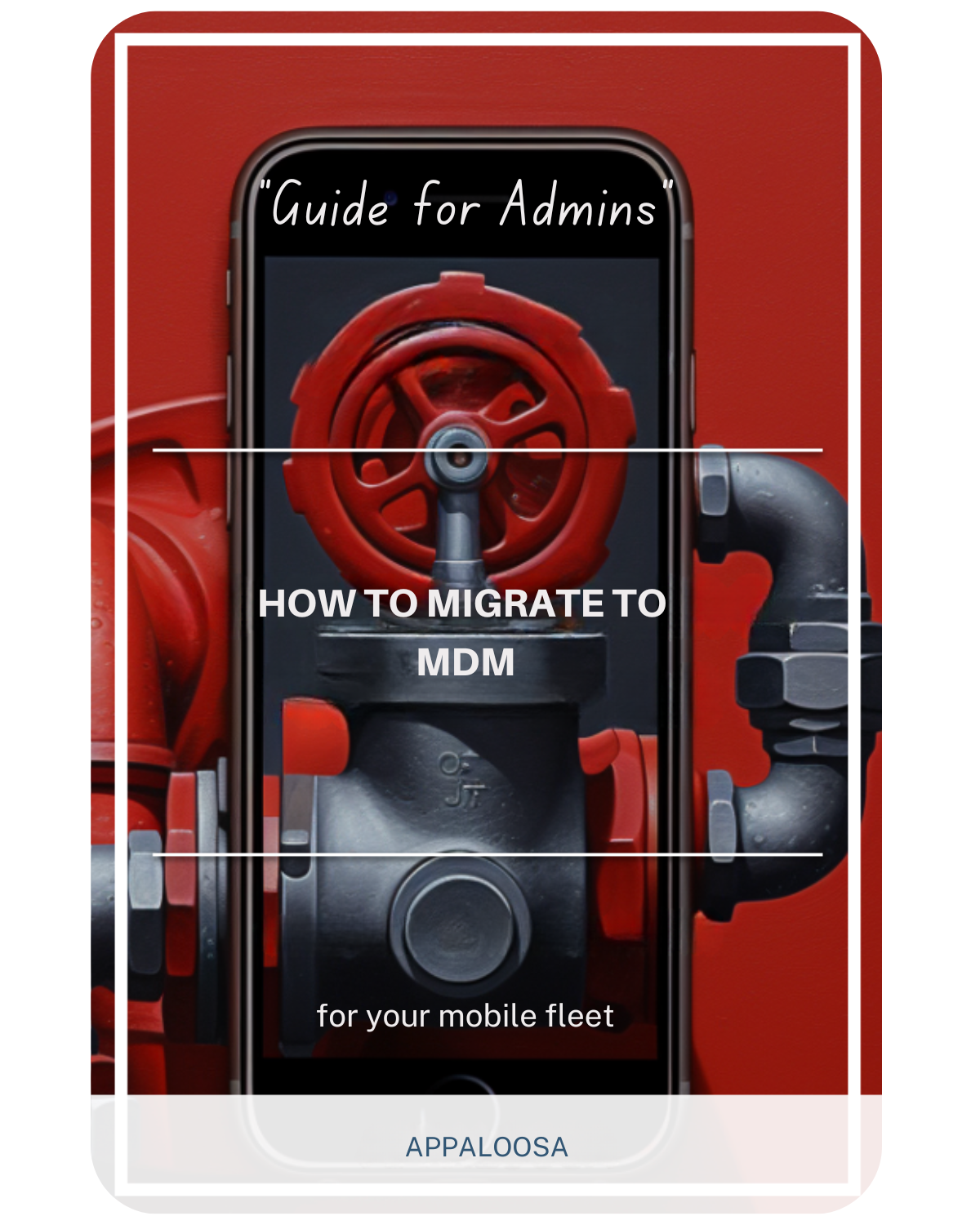How to Create the Perfect MDM Policy

In today's digital workplace, devices range from smartphones and tablets to laptops and wearables. Because of this, organizations of all sizes need a strong mobile device management policy.
With more people working from home and using their own devices, businesses need to balance productivity and security. They must protect sensitive company data from loss and security breaches.
This guide will walk you through the process of developing an effective mobile device management MDM policy that helps you secure mobile devices while maintaining employee satisfaction and operational efficiency.
Understanding the Importance of MDM Policies
Before diving into the creation process, it's crucial to understand why a well-crafted mobile device management policy matters. Recent statistics show that 70 million smartphones are lost each year, with only 7% recovered. Without proper policies in place, these lost devices can become gateways for unauthorized access to corporate networks and personal data breaches.
A robust mobile device management MDM policy helps organizations:
- Prevent unauthorized access to corporate resources
- Protect against data loss through device theft or compromise
- Ensure compliance with industry regulations
- Maintain visibility over device usage patterns
- Enable quick response when devices are lost or stolen
- Manage devices securely across the entire organization
- Implement comprehensive security measures across all endpoints
Step 1: Define Your Policy Scope and Objectives
The foundation of any effective mobile device management policy begins with clearly defining its purpose and scope. Start by answering these fundamental questions:
Identify Your Primary Goals
- What types of devices included in your policy? (smartphones, tablets, laptops, wearables)
- Are you implementing BYOD, corporate-owned devices, or both?
- What specific security threats are you addressing?
- Which departments or user groups will be affected?
- How will you manage devices securely across different platforms?
- Which MDM solutions will best support your objectives?
Set Clear Boundaries
Your mobile device management policy should explicitly state:
- Which operating systems are supported (iOS, Android, Windows)
- Minimum device requirements and specifications
- Geographic limitations or restrictions
- Time-based access parameters
- Methods for protecting sensitive information
- Required security measures for different device types
Step 2: Establish Access Controls and Authentication Requirements
Strong access controls form the backbone of device security. Your mobile device management MDM policy should mandate multi-layered authentication measures to ensure only authorized users can access corporate resources.
Implement Authentication Standards

- Password Requirements: Enforce complex passwords with minimum 8-character length
- Biometric Authentication: Leverage fingerprint, facial recognition, or voice authentication
- Multi-Factor Authentication (MFA): Require additional verification for sensitive applications
- Session Management: Set automatic lock timers and session timeout parameters
Configure Role-Based Access
Implement granular access controls that:
- Limit users to only necessary applications and data
- Enforce the principle of least privilege
- Create different access levels based on job roles
- Enable temporary access for contractors or guests
- Monitor device usage patterns for anomalies
- Integrate with enterprise MDM solutions for centralized management
Step 3: Design Security Configurations and Controls
To effectively secure mobile devices, your policy must outline specific technical configurations that all devices must maintain. These security measures should be comprehensive and enforceable through your chosen MDM solutions.
Essential Security Settings
- Device Encryption: Mandate full-disk encryption for all enrolled devices
- Operating System Updates: Require devices to run supported OS versions
- Anti-Malware Protection: Install and maintain approved security software
- Network Security: Configure VPN requirements for accessing corporate resources
- Data Protection: Implement measures for protecting sensitive corporate information
Remote Management Capabilities
Ensure your mobile device management policy includes provisions for devices to be remotely locked or wiped when:
- An employee reports a device as lost or stolen
- Suspicious activity is detected
- An employee leaves the organization
- A device fails compliance checks
- Real time threats are identified
- Immediate action is needed to remotely wipe compromised devices
Step 4: Develop Device Enrollment and Lifecycle Management Procedures
Smooth device enrollment processes are crucial for user adoption and security compliance. Your mobile device management MDM policy should detail step-by-step procedures for various scenarios.
Enrollment Workflows

Create clear processes for:
- New Employee Onboarding: How devices are provisioned and configured
- BYOD Enrollment: Steps for employees to enroll personal devices
- Device Replacement: Procedures for upgrading or replacing devices
- Guest Access: Temporary enrollment for contractors or visitors
- MDM Solutions deployment: How to install and configure management software
Lifecycle Management
Define procedures for:
- Regular compliance checks and audits
- Certificate and credential rotation
- Software updates and patch management
- Device retirement and secure data deletion
- Managing devices securely throughout their lifecycle
- Implementing security measures at each lifecycle stage
Step 5: Implement Real-Time Monitoring and Response Protocols
Modern mobile device management MDM requires real time visibility into device status and potential security threats. Your policy should establish continuous monitoring practices through advanced MDM solutions.
Monitoring Requirements
- Device Compliance Tracking: Monitor devices for policy violations in real time
- Usage Analytics: Track device usage patterns and anomalies
- Security Event Logging: Record all security-related activities
- Location Tracking: Enable GPS tracking for lost device recovery
- Threat Detection: Implement security measures for identifying compromised devices
Incident Response Procedures
Develop clear escalation paths for:
- Detected malware or suspicious applications
- Repeated failed authentication attempts
- Devices accessing restricted resources
- Non-compliant device behaviors
- Situations requiring devices to be remotely locked
- Scenarios demanding immediate remotely wipe actions
Step 6: Address Privacy and Legal Considerations
Balancing security with privacy is crucial, especially for BYOD programs. Your mobile device management policy must clearly delineate between corporate and personal data management.
Privacy Protections
- Data Separation: Use containerization to isolate work and personal data
- Monitoring Limitations: Clearly state what is and isn't monitored
- Personal App Restrictions: Define boundaries for personal application usage
- Data Collection Transparency: Inform users about collected data types
- Selective Wipe: Enable remotely wipe functionality that removes only corporate data
Legal Compliance
Ensure your policy aligns with:
- GDPR requirements for EU operations
- CCPA for California residents
- HIPAA for healthcare data
- Industry-specific regulations for protecting sensitive information
- Local privacy laws affecting mobile device management MDM implementations
Step 7: Create Application Management Guidelines
Effective app management prevents data loss through unauthorized applications while maintaining productivity. Your MDM solutions should support comprehensive application control security measures.
Application Policies
- Approved App Lists: Maintain whitelists of sanctioned applications
- Blacklisted Apps: Identify and block high-risk applications
- App Distribution: Use enterprise app stores for deployment
- Data Sharing Controls: Restrict copy/paste and file sharing between apps
Security Controls
Implement measures to:
- Prevent data loss through consumer cloud services
- Block screen recording in sensitive applications
- Disable printing from corporate apps
- Encrypt data in transit and at rest
- Ensure applications handle personal data appropriately
- Deploy security measures through centralized MDM solutions
Step 8: Establish Training and Communication Protocols
Even the best mobile device management policy fails without proper user education and buy-in. Develop comprehensive training programs that cover:
Training Components
- Security Awareness: Why MDM policies matter for protecting sensitive data
- Enrollment Procedures: Step-by-step device enrollment guides
- Best Practices: Safe device usage habits
- Incident Reporting: How to report lost or compromised devices
- Policy Understanding: Explaining security measures and their importance
Ongoing Communication
- Regular security updates and reminders
- Policy change notifications
- Success stories and case studies
- Q&A sessions for user concerns
- Real time security alerts and updates
- Updates on new MDM solutions and features
Step 9: Define Compliance and Enforcement Mechanisms
Clear consequences for policy violations ensure adherence while maintaining fairness. Your mobile device management MDM policy should outline:
Compliance Monitoring
- Automated compliance checks
- Regular audit schedules
- Self-assessment tools
- Remediation timelines
- Real time compliance dashboards
- Integration with MDM solutions for automated enforcement
Enforcement Actions
Progressive disciplinary measures for:
- First-time violations
- Repeated non-compliance
- Serious security breaches
- Intentional policy circumvention
- Failure to maintain access controls
- Refusal to allow remotely wipe when required
Step 10: Plan for Regular Policy Reviews and Updates
The mobile threat landscape evolves rapidly, requiring regular mobile device management policy updates to address new risks and technologies.
Review Cycles
- Quarterly security assessments
- Annual comprehensive policy reviews
- Post-incident evaluations
- Technology refresh assessments
- Reviews of device usage trends
- Evaluation of current MDM solutions effectiveness
Update Triggers
Review your policy when:
- New device types enter the market
- Security vulnerabilities are discovered
- Regulations change
- Business requirements evolve
- New methods to secure mobile devices become available
- Better security measures or MDM solutions emerge
Best Practices for MDM Policy Implementation
Start with a Pilot Program
- Test policies with a small user group
- Gather feedback and refine procedures
- Document lessons learned
- Scale gradually across the organization
- Ensure you can manage devices securely at scale
- Validate MDM solutions before full deployment
Leverage Automation

- Use MDM software for policy enforcement
- Automate compliance checking
- Enable self-service device enrollment
- Implement automatic remediation
- Configure automatic device locking when remotely locked
- Set up automated remotely wipe protocols for high-risk scenarios
Maintain Flexibility
- Account for different user needs
- Allow exceptions with proper approval
- Balance security with usability
- Adapt to changing business requirements
- Ensure access controls remain appropriate
- Keep security measures proportionate to actual risks
Common Pitfalls to Avoid
Over-Restrictive Policies
Policies that are too restrictive can:
- Reduce employee productivity
- Encourage policy workarounds
- Decrease user adoption
- Create shadow IT problems
- Hinder legitimate device usage
- Undermine the effectiveness of MDM solutions
Insufficient Communication
Poor communication leads to:
- User confusion and frustration
- Increased support tickets
- Policy non-compliance
- Security vulnerabilities
- Improper handling of personal data
- Resistance to necessary security measures
Neglecting Privacy Concerns
Failing to address privacy can result in:
- Legal complications
- Employee distrust
- Union disputes
- Reputational damage
- Violations of personal data protection laws
- Challenges implementing remotely wipe capabilities
Measuring Policy Effectiveness
Track key metrics to ensure your mobile device management policy achieves its objectives:
Security Metrics
- Number of security incidents
- Time to detect and respond to threats
- Compliance rates across devices
- Data loss prevention success
- Effectiveness of access controls
- Success rate of remotely wipe operations
Operational Metrics
- Device enrollment rates
- Support ticket volumes
- User satisfaction scores
- Policy exception requests
- Real time monitoring effectiveness
- MDM solutions performance metrics
Business Impact
- Productivity improvements
- Cost savings from standardization
- Reduced security-related downtime
- Compliance audit results
- Success in protecting sensitive business assets
- ROI of implemented security measures
Conclusion
Creating the perfect mobile device management policy requires careful planning, stakeholder collaboration, and ongoing refinement. By following this step-by-step guide, organizations can develop policies that effectively secure mobile devices while enabling productive mobile work.
Remember that a mobile device management MDM policy is a living document that must evolve with your organization's needs and the changing threat landscape. Regular reviews, user feedback, and continuous improvement are essential for maintaining an effective mobile device management strategy that manages devices securely.
The investment in developing a comprehensive mobile device management policy pays dividends through reduced security risks, improved compliance, and enhanced employee productivity. As devices include an ever-growing variety of endpoints in business operations, the importance of well-crafted MDM policies and robust MDM solutions will only grow.
Take action today to protect your organization's mobile ecosystem. Whether you're starting from scratch or refining existing policies, the time to strengthen your mobile device management approach is now. With the right policies and security measures in place, including the ability to remotely wipe compromised devices, you can confidently embrace mobile technology while protecting sensitive corporate assets and maintaining regulatory compliance.
